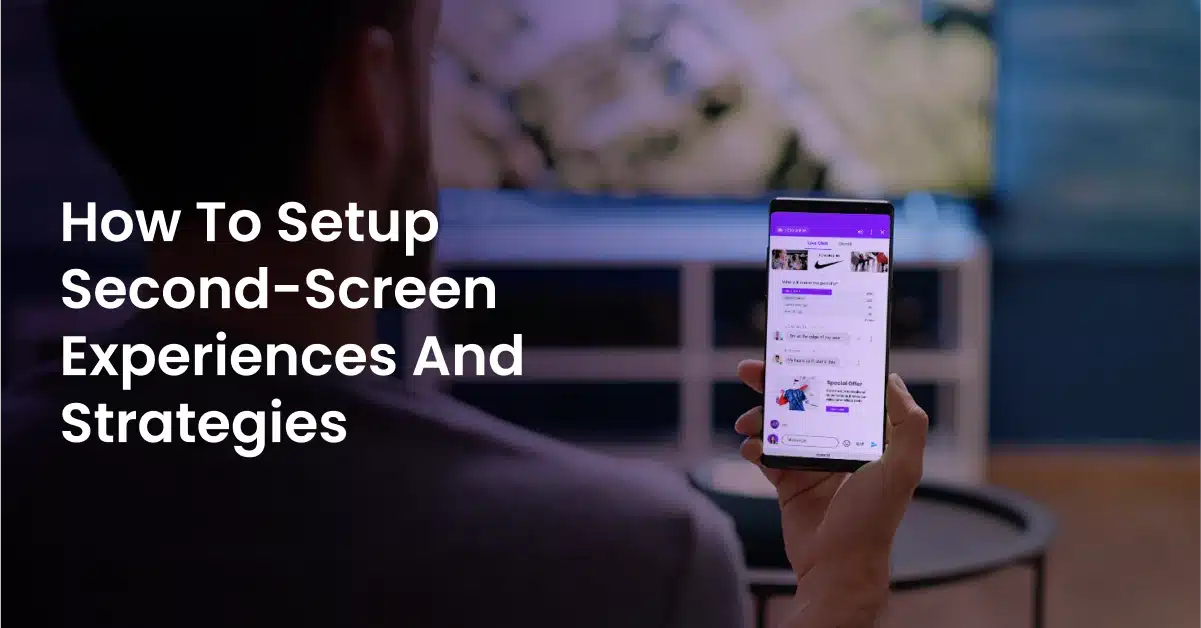Second-screen experiences are a powerful way to engage your audience deeply. Instead of fighting multitasking and digital distractions, an effective second-screen experience works with these audience viewing habits.
From your audience’s perspective, a second-screen experience has two elements: viewing experience on a primary screen (typically a TV) and using a secondary screen (e.g., a tablet, laptop, or smartphone).
Offering a second-screen experience is particularly important in a few cases. Enjoying a second screen is very popular with Gen Z and Millennials, who spend hours online daily. Also, a second-screen experience can augment a primary screen experience.
Alternatively, you can use a second-screen experience to build your piggyback audience style – offering commentary and additional information about the primary screen experience.
For your second-screen experience to succeed, it has to be grounded in strategy. Use our quick strategy planning process to verify that a second-screen offering is a good fit for your
Building Your Second-Screen Strategy
The following strategy is intentionally designed to be fast and easy. It is designed to help you answer two questions. First, is a second-screen experience a good fit for your business goals right now? Second, this process will help you plan your first few second-screen experiences.
As your second-screen experience grows, you can integrate this offering into your standard digital planning processes.
1) Choose A Goal
Focus is your friend when planning a second-screen experience. There are typically a few common goals most second-screen efforts advance:
- Audience Engagement
- Audience Growth
- Advertising Growth
- Conversions
Generally speaking, achieving audience goals (i.e., audience engagement or audience growth) is an easier objective to pursue when you first get started offering second-screen experiences..
2) Find Your Angle
When you offer a second-screen experience, you are competing against other sources of entertainment for your audience’s limited attention. In a best-case scenario, your audience is already switching back and forth between their primary screen and what you have to offer.
Your angle – or unique value proposition – may be to offer the best and fastest commentary on a breaking news event. Or your might focus on timing – being the first to offer pre-event coverage.
The best part is that second-screen experiences – especially those based on live chat and live blogs – are flexible. You can change the timing, format, and concept later if you find out that your initial idea doesn’t hit the mark.
3) Review Audience Behavior
Looking at the recent audience discussions on social media is a powerful way to generate ideas. For example, are fans creating meme images around their favorite moments? Or are people focused more on speculating about the twists and turns of a story?
Understanding existing second-screen behaviors makes it easier to refine your second-screen experience. If you’re hosting a social experience – like a live chat on your website – the shape of the experience will be determined partly by your audience and the host. Having some prepared questions, talking points, and even special guests can help to keep the event moving.
4) Promote The Second Screen Experience
Once you have your second-screen experience planned, give yourself the time and resources to promote the experience properly. This is where your unique angle will help you to garner attention. If you have influencers or celebrity guests, invite them to join you in promoting the event.
5) Measure Your Success
The day after you run a second-screen experience, take some time to measure your results. Did you make progress toward your goal? If not, there are a few causes to explore, like insufficient event promotion, a lack of a unique angle, or failure to meet audience needs. Run at least 2-3 second-screen experiences before deciding whether or not to pause or abandon to pivot toward other ways of reaching your audience goals.
Download our white paper “Generation Z and the Rise of the Second Screen” and transform your engagement strategy today.
Set Up Your Second-Screen Experience In Less Than An Hour
Once you have your strategy, you can launch your second-screen experience in less than an hour. With some practice, you can set up a second-screen capability even faster.
The following techniques will help you to design a more engaging experience for your audience and get closer to your goals.
1) Build Multiple Social Sharing Opportunities
Word of mouth is one of the best ways to promote your second-screen offering. That’s why it is critical to have several social sharing opportunities. Start by choosing one or two social media hashtags for your audience. You might use a mix of general event hashtags (e.g., #SuperBowl) and ones you create for your purposes (e.g., #SuperBowlSuperFans).
2) Improve Integration With The Primary Screen
Maintaining a close link to the primary screen experience is vital to keep your audience engaged. To maintain this link, start by doing your homework. Watch previous episodes of the show or last year’s event coverage if possible. In addition, make sure you are watching along with your audience.
Developing significant expertise in some areas of film or television can be difficult, especially for a long-running franchise. Inviting a guest influencer with deep knowledge can help keep your second-screen experience, like a live chat session on your website, aligned with what’s happening on the primary screen.
3) Offer Rewards To Your Fans
Giving out rewards and prizes to your fans is a great way to boost interest. Aim to tie your giveaways to the primary screen experience for the best results. For instance, you might give away signed sports cards for the best comment or question during a live chat session.
Giving away your products as a reward can also work. A publisher might give away a free premium subscription to one live chat participant. That’s a quick way to make your second-screen experience more compelling.
4) Make Your Second-Screen Experience Highly Interactive
Put yourself in the shoes of your audience for a moment. They’re sitting on the couch watching TV and have their phones out. They’re likely focusing most of their attention on the primary screen (i.e., the TV). They’ll only look down on their mobile devices occasionally.
In that context, interacting with others needs to be simple and easy. Only some people will want to write out comments. This is where offering more interactive options comes in.
Use polls, social reactions, and links regularly so that your audience has more ways to participate. These interactive options are quick and straightforward, even if a participant only has a few moments to view their second screen.
Launch Your Second-Screen Experience Fast
Getting a second-screen experience up and running quickly is essential, especially if your offering aligns with a broadcast event. That’s why you need technology that is easy to implement – with no engineering support needed. Find out how Arena can help you build your digital community on your website.



